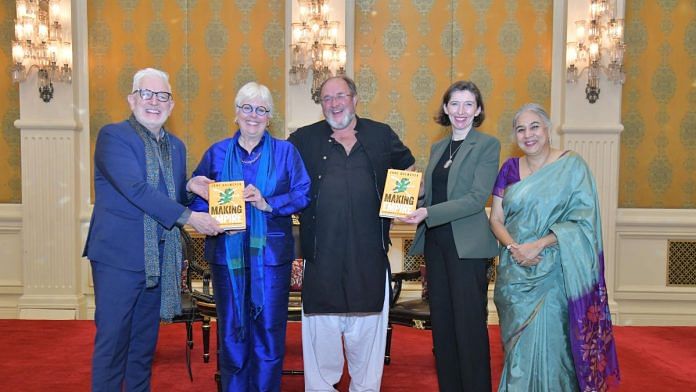New Delhi: The coloniser and the colonised shared a stage on a chilly evening at The Leela Palace in Delhi. And didn’t end in a stand-off. Instead, it led to a complex discussion on the impact of Britain’s colonisation of Ireland, and the Raj in India.
The irony is that the Irish helped make the British Empire. It also later unmade it with its independence movement which unfolded around the same time an Irishman in India—Michael O’Dwyer—allowed the Jallianwala Bagh massacre in Amritsar to happen.
“Both Irish catholics and protestants were active agents in the making of the Empire,” said Jane Ohlmeyer, professor of modern history, Trinity College Dublin, at the launch of her latest book, Making Empire: Ireland, Imperialism & the Early Modern World. In conversation with historians William Dalrymple, who is from Scotland with Irish heritage, and Swapna Liddle, Ohlmeyer re-examined the process of making an empire and the impact of London’s imperial outlook for centuries.
The line between the coloniser and the colonised is blurred when we look at the history of colonialism in Ireland. It was invaded by the United Kingdom in the 12th century, and gained independence in 1922.
The book launch was noteworthy given that it was jointly organised by the Embassy of Ireland and the British High Commission – an unimaginable combination, perhaps even three decades ago. The ballroom was also packed with a number of ambassadors and diplomats from various missions in India.
“To understand the Empire today we really have to go back to the early modern period. Ireland is important because the Irish were also trans-imperial. The Irish were active in all the European empires and even the spiritual empires – through the Catholic schools and the Jesuits,” said Ohlmeyer.
If the role of the Irish as agents of the British was integral in expanding London’s reach across the world, the Irish lords themselves were some of the most important figures of resistance during the early modern period of the world.
“At the time of Ireland’s independence, we did not want to talk about the Empire,” Ohlmeyer said.
Settler and career empires
India and Ireland, two countries and societies thousands of kilometres apart, have one thing in common – British imperialism. However, the process of colonisation and the Empire was different in both countries, noted Dalrymple.
“There are many types of Empire. One of the most important differences between the British in Ireland and in India is the settler versus career empires,” he said.
The British went to Ireland with the aim of dispossessing the Irish, throwing them out of their homes and capturing their land.
“But when Lord Cornwallis came to India after being defeated by the Americans in Yorktown, he made a crucial change to the British in India – they were not allowed to own land with exceptions. When officers reached retirement age, they got on a ship and went back to the UK,” Dalrymple added.
That single decision by Lord Cornwallis changed the very nature of the British Empire in India. In Ireland, the British nationalised eight million acres of land – a third of its total landmass. This was owned by a small number of merchants living in London, and the proceeds from this land was used to fund the first expansion of the British Empire, explained Ohlmeyer.
The Irish were used as indentured labour in Caribbean sugar plantations before the introduction of black chattel slavery. Ireland was restructured over centuries to feed the British Empire’s expansion, while a number of Irish travelled the globe as the foot soldiers and agents of the Crown’s will.
Also read: Amol Palekar wants the world to see his ‘gradations of grey’—memoir turns lens inward
Transnational decolonisation
The complicated history between Ireland and the UK was noted at the event, with even Diana Mickeviciene, the Ambassador of Lithuania, sitting in the audience, remarking that she was “positively jealous” of the “humane” way that the two countries are dealing with their colonial pasts.
Lithuania, the ambassador said, also has a long history of oppression but has yet to be able to have a discussion with Russia on it.
“Economic prosperity fuels the ability to have these conversations. Ireland has become very prosperous. As power decreases, it leads to these types of conversations,” said Dalrymple.
The conversation segued toward modern Irish policy—one of winning hearts and minds, to achieve the ultimate goal of reunification of Northern Ireland with Ireland. The partition of Ireland in 1921 was replicated in 1947 in South Asia, and later in Israel and Palestine, according to Ohlmeyer.
Historian and William Dalrymple’s son, Sam, who was in the audience, raised the history of the transnational nature of decolonisation, pointing out the example of the Chittagong Uprising in 1930, which was inspired by the Easter Rising of 1916 in Ireland. The leaders of the movement in Chittagong in the Bengal Presidency even carried small notes of messages from the Irish freedom fighters.
But for every inspirational freedom movement from Ireland, be it the Home Rule Movement or the Chittagong Armoury Raid, there will always be a Lord Mayo, who was the viceroy of India, or a Michael O’Dwyer who did his best to suppress the voices of Indians.
(Edited by Aamaan Alam Khan)







“Ireland. It was invaded by the United Kingdom in the 12th century”
Oh no it wasn’t… What an anachronistic comment… I haven’t even bothered to read the rest of the article….